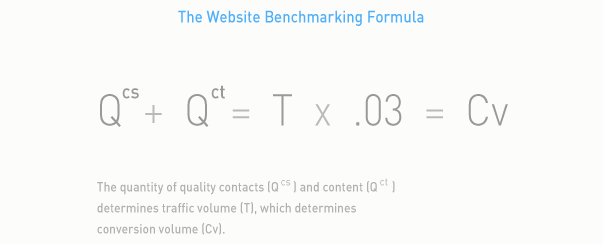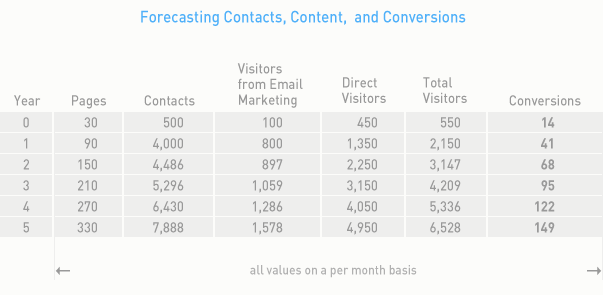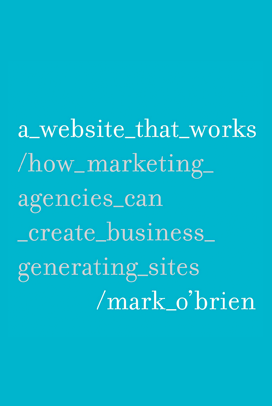Are you happy with your website?
If you’re like most agency principals, I know the answer is probably no. The typical agency principal is unhappy with their site. But why is that, and what’s the fix?
I don’t know if it’s something in the water or what, but the theme of 2013 so far seems to be “all or nothing.” It feels like a high-stakes year, and this is a high-stakes topic. There’s only one thing that I think will make and keep you, the small agency principal, happy with your site: money.
If you know that your site is generating business, you’re going to be happy with it. If it’s not, you won’t be. Sure, you were excited when you put your new site live, but you never were completely happy with the design, were you? Furthermore, the web is a shrine to entropy — what’s revolutionary today is dated tomorrow, and I know that agencies feel the burn of this as much as anyone.
So, you need a business-generating website. The question is, how can you reliably create such a site, and what are the key targets you should be shooting for that will add up to a business-generating website? This question was posed to me a year ago by one of our agency partners, Jason Mlicki of Rattleback, before we began working together on his new site. When he asked me what benchmarks he should target to ensure success, I was a little surprised and embarrassed to realize that I didn’t have a good answer. I definitely knew what the core strategy and components of the site ought to be, but I didn’t have enough hard numbers for him.
Since then, I’ve been closely observing what it takes to create and maintain a business-generating website for a small agency. Fortunately, we’re in a position that allows us lots of behind-the-scenes access to small agency sites, analytics, and principals. No one has spent more time thinking about and working on small agency websites over the past 18 years than Newfangled has. After reviewing hundreds of sites for small agencies across North America, I’ve put together 4 benchmarks that will ensure you are utilizing your site to its maximum potential. I can’t say how much business your site will generate, but I can say that if you’re hitting these targets, it’s going to be very hard for your site to not have a significant impact on your bottom line.
But how does your site affect your bottom line? Your site won’t independently close any business for you. It’s not a sales tool; it’s a marketing tool. Your site’s job is to regularly attract, inform, engage, and nurture qualified prospects (and employees), and that’s it. Your site affects your business by generating a significant volume of qualified leads, and then nurturing those leads through careful integration with a marketing automation tool.
The formula for these benchmarks is simple: the quantity of quality contacts and content determines traffic volume, which determines conversion volume (this tends to be 3% of overall traffic, but more on that later), which affects contact volume, repeat.

These 4 benchmarks are suggested benchmarks. Hitting the exact numbers isn’t necessarily critical, and there are some agencies that serve small niches that won’t support some of these numbers, but the general ballparks and relative proportions are sound. The first two benchmarks — content and contacts — are things you can control, and because of that I’ve gone into much greater depth there. The second two — traffic and conversions — are somewhat beyond your direct control in that they are the effects of the first two.
It will also be helpful for you to keep in mind that most agencies are not currently living up to these benchmarks, although many are certainly doing well on one or two. Some of these goals might sound like a real stretch at first, but I assure you that all of these numbers are attainable if you’re willing to do the things I suggest here, and I’ve made a point to only suggest things I know are entirely possible for any well-positioned small agency to do. Speaking of…
Wait, maybe you shouldn’t read this!
In the interest of saving time for those who won’t get anything out of this newsletter at all, I’d like to mention that I am making the assumption that yours is a well-positioned agency. If you’re an undifferentiated, full-service agency that is not precisely targeting a niche market, this newsletter is not going to help you. In fact, it might result in your wasting a lot of time and money. If you’re not well-positioned, you shouldn’t waste your effort on a content strategy, and you also can’t buy or earn a list of meaningful contacts because you’re not targeting any specific group. Without the right kind of content and contacts, your site has no hope of having a significant, long-term effect on your business. If you are well-positioned, or plan to become so soon, please keep reading.
(For more on positioning, check out David Baker’s site.)
Benchmark #1: Add 3,000 words of content to your site each month.
If you want your site to generate business, you need to continually feed it high-quality content. We define a content strategy as “a plan to regularly add unique, expert, and indexable content to your site.”
(There are many articles, webinars, and podcast on this site alone that deal with this topic in great detail. You can see a list of them here.)
What this basically means is that you need to add 3,000 words to your site each month. Forever. This content needs to be written by your firm, it needs to focus on your prime prospect personas (the people who will hire you), and it needs to be educational content that documents the overlap between your expertise and your prospects’ needs. 3,000 words sounds like a lot of words, and it is. This isn’t easy, but it also isn’t impossible, especially if you’re able to spread the workload across a few members of your firm. The platforms you use to house the content on your site don’t especially matter, as long as you’re sticking to our definition. A plan for getting to 3,000 words per month might include writing one 1,000-word newsletter each month and one 500-word blog post each week.
If you can distribute the writing effort across 2-4 people, it shouldn’t have to take up an inordinate amount of any one person’s time. If you’re an expert on your subject matter, you should expect to spend about 1 hour for every 500 words of content. This includes 30 minutes of writing time, 15 minutes of editing and publishing time, and another 15 minutes to create and/or choose imagery, optimize the post for search engines, and distribute the post through social media. A total time investment of 10 hours a month (again, hopefully distributed across the firm) should be enough to create and sustain an impactful, on-site content strategy.
Content is the price of admission to play in the web marketing arena. If you’re interested in your site ranking well in search engines, if you want your site to attract and convert qualified prospects, if you’d like to have a foundation for a fruitful social media strategy, if you’d like to take advantage of marketing automation, and if you want to be well-positioned for the next trend in digital marketing that hasn’t been invented yet, then you need a content strategy.
You also need a content strategy to maintain your edge. Writing about what you already know helps you to understand it at a deeper level, and you don’t truly master a subject until you figure out how to effectively communicate it to others. I began writing this newsletter last week, and I’ve already used the new connections it has fused in my thought process over the past few days on 3 different sales calls. There is no doubt writing this one newsletter has made me smarter. I’m going to go out on a potentially controversial but otherwise entirely stable limb and say that if you’re not writing and/or speaking about your expertise to your prospects on a regular basis, then you aren’t responsibly running your firm. Unique, expert content is the foundation of modern marketing, and I have never known a single agency that could afford not to market itself.
Benchmark #2: Have 4,000 Total Contacts in Your Marketing Lists.
When I started paying close attention to the impact the average small agency website had on the business it served, I noticed two things right away. One, the traffic at the average small agency was way too low (typically between 10 and 50 unique visitors per weekday), and two, the traffic always spiked when the agency sent out their monthly newsletter. I knew that small agencies had to increase their traffic in order to give their sites a chance to impact their businesses, and I quickly realized that increasing their database of contacts was absolutely the best way to do this. The question was, what is the best way to increase the number of contacts?
There is no topic I’ve changed my position on more drastically than that of how to build a contact list. For years I resolutely believed that building up a list naturally, primarily through people signing up for something on your site, was the only legitimate approach.
The issue with this is that it leaves most small agencies in a chicken-egg quandary. Let’s assume your site has a 3% conversion rate across all calls to action or web forms. I’d consider this rate to be fairly typical on average in this space. If you had 40 people per weekday visiting your site, that’d add up to roughly 800 unique visitors per month (weekend traffic on agency sites is usually too insignificant to consider). At a 3% conversion rate, you’d be adding only 24 new subscribers per month.
Now I’m recommending that you have 4,000 contacts total. Most small agencies only have about 10% of that. Building your list from 400 contacts to 4,000, at 24 new contacts per month, would take 12 years! Uh oh.
You can see the chicken-egg issue here. The number of contacts you have has a huge impact on your traffic, but if you don’t have much traffic, you’re not going to be able to easily increase your contacts. If you have a small list (400 contacts) and you’re not getting much traffic (800 monthly visitors), it’s going to take way too long to “earn” your way up to the recommended number of contacts. What’s more, contacts earned over long periods of time tend not to be anywhere near as focused as a group when compared with newly purchased contacts.
The reason you need 4,000 contacts is to get your overall monthly traffic up to the levels I’m recommending for the site to serve you well. Let’s take a conservative estimate again and assume that your email blasts have a 20% click-through rate. If you have 4,000 contacts you’re emailing once a month and a 20% click-through, you’re getting an extra 800 people to your site each month. If you’re one of the thousands of small agencies in North America out there getting around 40 (or fewer) unique visitors per weekday, this one change alone would double your monthly traffic, from 800 unique visitors to 1,600, or from 40 to 80 per weekday. Once you get to an average of 80 visitors per weekday, you’re within striking distance of the 100 I recommend below, and you’ll easily ratchet up to that over the course of the next year if you’re adding 3,000 words of content to the site each month. You can see how all of these benchmarks are interdependent.
So 4,000 is the magic number, and you don’t have the time it takes to earn them. As far as I know, that leaves you with only one choice. It’s time to buy a contact list. I’ve got a two-part webinar coming up called “Contacts and Content.” The first part, on contacts, is next month. Dave Currie, CMO of The List, will be joining me, and together we will tell you why buying a list is the right option, how to buy the right kind of list, how to ensure you’re complying with the Can-Spam Act when emailing that list, what sort of unsubscribe rate you should expect (it’s way lower than you think), and how to get the most out of your purchased list.
Since realizing that earning a sizeable-enough list over time was probably not a possible approach for most small agencies, we’ve been heavily experimenting with list purchasing for the past year, and I’m shocked by how effective a technique it is. I hope you’ll join our webinar next month to hear about all the details. In the meantime, if you’re interested in learning more about list purchasing and The List, which is the top service I recommend, check out their site.
Benchmark #3: 100 Unique Visitors Per Weekday
The first two benchmarks are completely in your control and immediately attainable. Right now, you can choose to start writing content, and you can buy a list. The second two metrics — traffic and conversions — are outside of your direct control, but they are the direct result of the first two benchmarks, which you can control.
In my book, A Website That Works, I wrote that “traffic is meaningless, action is everything.” What I was reacting to there was the tendency of many business to set traffic as the only goal. There are few things more dangerous in life than setting the wrong goal, and when traffic is the goal of your site, all sorts of things go wrong (like keyword-stuffing your content for SEO, for example). When your goal is converting qualified prospects, you’re going to make lots of good decisions as you travel down your marketing path. A certain amount of traffic is necessary, though. For small agencies, 100 unique visitors per weekday seems to be the right goal. That equals at least 2,000 visitors per month, and if you are at a 3% conversion rate, that should equal roughly 60 conversions per month.
More than 2,000 visitors per month is not a problem, of course, and when you follow all of my recommendations here, you should see a steady (~20%) year-over-year increase.
Benchmark #4: 50 – 100 Conversions Per Month
Being the “conversion-focused” evangelists we are at Newfangled, it makes sense that it would all come down to this. Again, the goal of the site is to generate business, and it does that by attracting, informing, engaging, and nurturing qualified prospects. The conversion is the most critical point of this whole process, because that is when the power in the marketing relationship switches from your prospect to you. Prior to the moment your prospects convert by giving you their information through a web form on your site in exchange for something you’re offering, you cannot directly market to or nurture them as a lead because you don’t know who they are. As soon as they convert, you know and can learn a lot about them. Once you give someone your email address these days, they can instantly find out a lot about you, potentially including, but not limited to, your picture, full name, employer, title, bio, Twitter history, and any publicly available content you may have on Facebook.
This is why conversions are the goal of the site, and you need a certain critical mass of them in order to have an impact on your business. The more conversions, the more opportunity you have to nurture those prospects into viable leads as they progress through the stages of the buying cycle. This type of nurturing is what marketing automation is all about. If you’re interested in digging deeper into the amazing benefits of marketing automation, feel free to check out my recent webinar on it.
Moving Beyond the Benchmarks
Adding 3,000 words of content to your site each month, say through the blog and newsletter approach I mentioned, will add around 60 new pages to your site each year. Most small agency sites have around 30 or so standard (non-content strategy) pages on their site. If you embrace this model, you’ll triple the size of your site in the first year alone, and by the end of year three, you’ll have over 200 pages.
The deeper a resource your site is, the more traffic you’re going to get from search engines. This isn’t an exact rule, but it seems that B2B sites with focused, unique, expert content tend to receive roughly .75 users per weekday for every page of content, and it’s not uncommon for 40-60% of that traffic to come from search engines. Site growth attracts more traffic, which creates more conversions, which increases your contacts list, which attracts more traffic and generates more qualified leads.
How Long Does it Take?
If you’re willing to start your content strategy and buy a targeted list of 4,000 prospects today, I’ll bet that you’ll meet all of these benchmarks in 12 months or so. To help you forecast the impact this approach could have on your site, I’ve created a spreadsheet that calculates and demonstrates the relationship between contacts, content, and conversions. It is listed below graphically (thanks, Chris Butler, for this and all the graphics here!), but if you’d like the raw Excel version, send a nice note to me at Mark at Newfangled.com.

Again, this all presupposes that you are a specialized, well-positioned agency, and that you know how to write at a decent level. If you’re a generalist, I sincerely suggest you not do any of this, not because I’m trying to keep you out of the club, but because I don’t see how this could be anything but a huge waste of time and money for you.
If you are a specialized agency, I hope this newsletter and the linked resources have given you enough information and motivation to get started, and I hope it serves you well. If you need help tying it all together or getting that conversion-focused site built, let’s talk.



